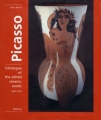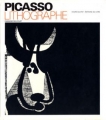
Zaidan Gallery
|
We have 10 Picasso Prints for Sale (Click on picture to enlarge) |
|||||||||||||||||||||||||||||||||||||||||||||||||||||||||
| Chapeau et Raisins | Bouquet de Fleurs | L'Age de Soleil (Pour Roby) | |||||||||||||||||||||||||||||||||||||||||||||||||||||||
 |
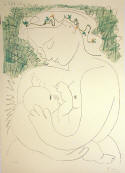 |
 |
 |
 |
|||||||||||||||||||||||||||||||||||||||||||||||||||||
|
Bull & Picador, before the thrust
|
La Maternite |
FROM LA SUITE VOLLARD |
|
||||||||||||||||||||||||||||||||||||||||||||||||||||||
|
His real work and career as a painter is said to begin around 1894 with a painting called The First Communion which showed his sister Lola; and the more famous painting by Pablo Picasso called Portrait of Aunt Pepa. In 1897, his realistic style of painting became influenced by Symbolism and came across in a series of landscapes where he used violet and green tones in the colors.
From 1899 to 1900 was a period where Picasso was creating paintings in a Modernist style which emerged due to his influence and exposure to the works of Rossetti, Edward Munch, etc. In the year 1900, Picasso visited Paris for the first time. He lived with a friend, Max Jacob, who was a journalist and a poet. This was just the beginning of Picasso's career. These were difficult times, spent in misery and hunger. In 1901, Picasso started a magazine called 'Arte Joven' in Madrid with his friend Soler. He completely illustrated the first edition of the magazine. While in Paris, Pablo Picasso had a propensity for entertaining and had among his friends people such as Andre Breton and Gertrude Stein. Gertrude Stein proved to be one of his earliest and most loyal art collectors. All the paintings by Pablo Picasso are usually classified into various 'periods' based on the moods and styles of the paintings. These, in turn, were largely affected by his personal and love life. The Blue Period: 1901 to 1904 is called Picasso's Blue Period because many of his paintings in that time were in the shades of blue and blue-green. The subjects of these paintings were prostitutes and beggars. Some of the famous paintings by Pablo Picasso during this period were La Vie, The Blindman's Meal and a portrait called Celestina. An etching called the Frugal Repast also reflected his somber mood of the time. Blindness and destitution were an integral part of this theme of paintings. It was also during this time, that he began using the image of a harlequin, in checkered clothing, as his personal motif in his paintings. The Rose Period: 1905 to 1907 is called Picasso's Rose Period where his paintings became cheerful with the use of orange and pink colors. These paintings also featured harlequins. Garçon à la pipe, La famille de saltimbanques and The Actor are some of the notable paintings by Picasso, belonging to this period. African Period: 1907 to 1909 is called his African-Influenced Period where Picasso's drawings were inspired by African artifacts. A good example of this period is his painting titled Les Demoiselles d'Avignon. This painting actually shook the art world. The story even says that Picasso hid this painting for a very long time and had shown it only to few very close friends. As he had predicted, the painting definitely created a stir when it was first showcased. Cubism: 1909 to 1912 is called Picasso's Analytic Cubism Period. This style of painting was developed along with Georges Braque and was characterized by the use of monochrome brown colors. He took the objects apart and analyzed them within the medium of his paintings. 1912 to 1919 is called Picasso's Synthetic Cubism Period where he began to use collage in his art. He would add paper fragments of wallpaper or newspaper pages and paste them into his work. During the 1930s he returned to a more neo-classical style of painting. Another major change was the use of the Minotaur as his motif, rather than the harlequin in his paintings. His famous painting called Guernica depicted the brutalities, and the hopelessness induced by war. In the 1950s he started reinterpreting the works of great masters, including Velazquez, Goya, Manet and Delacroix. In 1967, the Chicago Picasso was unveiled. This huge 50 foot sculpture made on abstract themes defies interpretation. It could be a woman, or a bird or a horse or quite simply anything. Picasso did not take the $100,000 payment offered for it, but donated it all to the people of the city. From 1968 to 1971, he produced several paintings and copperplate etchings in the style, now known as neo-expressionism. When these paintings were made, they were dismissed by critics as being the 'pornographic fantasies of an old man' and the 'incoherent scribblings of a frenetic old man'. Love Life of Picasso Along with his art, Picasso's love life was also always the center of attention for his fans. In 1904, Picasso began a relationship with Fernande Olivier who appears in some of his Rose Period Paintings. Picasso left her for Marcelle Humbert, who he used to call Eva, and declarations of his love for her are seen in his Cubist paintings. In 1918, Picasso married Olga Khokhlova who was a ballerina in Sergei Diaghilev's troupe. Picasso was designing a ballet for him called 'Parade' in Rome. She was fond of high society life and introduced Picasso to it. They had one son, called Paulo. Her socializing and Picasso's bohemian lifestyle clashed often and their marriage was not successful. They separated when Picasso began a secret affair with 17 year old Marie-Thérèse Walter. Since the French Law required that Picasso give half of his property to Khokhlova upon divorcing her, and since Picasso did not want her to have half of his wealth, they never divorced, but remained separated till she died in 1955. Picasso continued his affair with Marie-Thérèse for a long time, and even had a daughter called Maia with her. She lived in the hope that he would marry her some day, which Picasso never did. Four years after Picasso's death, Marie-Thérèse hanged herself. Photographer and painter Dora Maar was also a constant companion and a lover of Picasso during the 1930s and early 1940s. She even documented the painting of the 'Guernica'. In 1944, Picasso began an affair with a young art student called Francoise Gilot. They had two children, Claude and Paloma. She was the first woman in Picasso's life who left him because of his many infidelities. This was in the year 1953. Picasso was greatly disturbed by this. He was in his 70s now and began to see his old age from a very depressing point of view. He had a six week-long affair with a beautiful and young girl called Genevieve Laporte, probably on the rebound. Then he met Jacqueline Roque, who worked at Madoura Pottery where Picasso made and painted ceramic art. They were together till Picasso's death. They married in 1961 so that Picasso could take revenge on Gilot. Gilot, with Picasso's encouragement, filed divorce with her husband and then was going to marry Picasso in order to legitimize the status of her two children and secure their rights. But, when Gilot filed the divorce papers, he went ahead and secretly married Roque to foil her attempts and thus got revenge for her leaving him. BBC - The Life and Work of Pablo Picasso
Apart from these, there are hundreds of other intriguing paintings by Picasso. Till date, Picasso remains one of the most notable and recognized painters of the modern age. He is also rightly acclaimed as one of the most influential artists of the century!
Artistic Periods: Blue Period (1901-1904)
Rose Period (1904 - 1906) African Period (1907 - 1909) Cubism (1909 - 1917) Neoclassicism (1918 - 1925) Surrealism (1925 - 1936) War in Spain. Guernika. World War II (1937-1945) Peace (1945 - 1960) Last years (1960 - 1973)
|
|||||||||||||||||||||||||||||||||||||||||||||||||||||||||
|
|||||||||||||||||||||||||||||||||||||||||||||||||||||||||
This Video is Courtesy of http://www.5min.com/ |
|||||||||||||||||||||||||||||||||||||||||||||||||||||||||
|
Picasso Quotes: Action is the foundational key to all success. Brainy Quote |
He can who thinks he can, and he can't who thinks he can't. This is an inexorable, indisputable law. Pablo Picasso I am always doing that which I cannot do, in order that I may learn how to do it. Pablo Picasso I begin with an idea and then it becomes something else. Pablo Picasso I do not seek. I find. Pablo Picasso I don't believe in accidents. There are only encounters in history. There are no accidents. Pablo Picasso I have a horror of people who speak about the beautiful. What is the beautiful? One must speak of problems in painting! Pablo Picasso I paint objects as I think them, not as I see them. Pablo Picasso I'd like to live as a poor man with lots of money. Pablo Picasso If all the ways I have been along were marked on a map and joined up with a line, it might represent a minotaur. Pablo Picasso If only we could pull out our brain and use only our eyes. Pablo Picasso If there were only one truth, you couldn't paint a hundred canvases on the same theme. Pablo Picasso Inspiration exists, but it has to find us working. Pablo Picasso Is there anything more dangerous than sympathetic understanding? Pablo Picasso It is your work in life that is the ultimate seduction. Pablo Picasso It takes a long time to become young. Love is the greatest refreshment in life. Pablo Picasso My mother said to me, "If you are a soldier, you will become a general. If you are a monk, you will become the Pope." Instead, I was a painter, and became Picasso. Pablo Picasso Never permit a dichotomy to rule your life, a dichotomy in which you hate what you do so you can have pleasure in your spare time. Look for a situation in which your work will give you as much happiness as your spare time. Pablo Picasso One does a whole painting for one peach and people think just the opposite - that particular peach is but a detail. Pablo Picasso |
||||||||||||||||||||||||||||||||||||||||||||||||||||||||
|
|||||||||||||||||||||||||||||||||||||||||||||||||||||||||
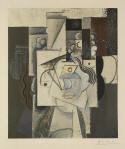
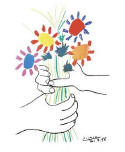
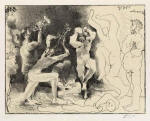

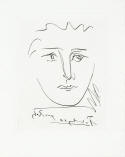
 Pablo Ruiz Picasso (his full name was Pablo Diego José Francisco de Paula Juan Nepomuceno María de los Remedios Crispín Crispiniano de la Santísima Trinidad Ruiz y Picasso) was born on October 25, 1881 to Don José Ruiz Blasco and Doña Maria Picasso y Lopez. The family lived in Málaga, Spain, where Don José, a painter himself, taught drawing at the local school of Fine Arts and Crafts, and also the curator of a local museum.. Pablo spent the first ten years of his life there. The family was far from rich, and when 2 other children were born it was often difficult to make ends meet. When Don José was offered a better-paid job, he accepted it immediately, and the Picassos moved to La Coruna, where they lived for the next four years. In 1892, Pablo entered the School of Fine Arts there, but it was mostly his
father who taught him painting.
Pablo Ruiz Picasso (his full name was Pablo Diego José Francisco de Paula Juan Nepomuceno María de los Remedios Crispín Crispiniano de la Santísima Trinidad Ruiz y Picasso) was born on October 25, 1881 to Don José Ruiz Blasco and Doña Maria Picasso y Lopez. The family lived in Málaga, Spain, where Don José, a painter himself, taught drawing at the local school of Fine Arts and Crafts, and also the curator of a local museum.. Pablo spent the first ten years of his life there. The family was far from rich, and when 2 other children were born it was often difficult to make ends meet. When Don José was offered a better-paid job, he accepted it immediately, and the Picassos moved to La Coruna, where they lived for the next four years. In 1892, Pablo entered the School of Fine Arts there, but it was mostly his
father who taught him painting. 